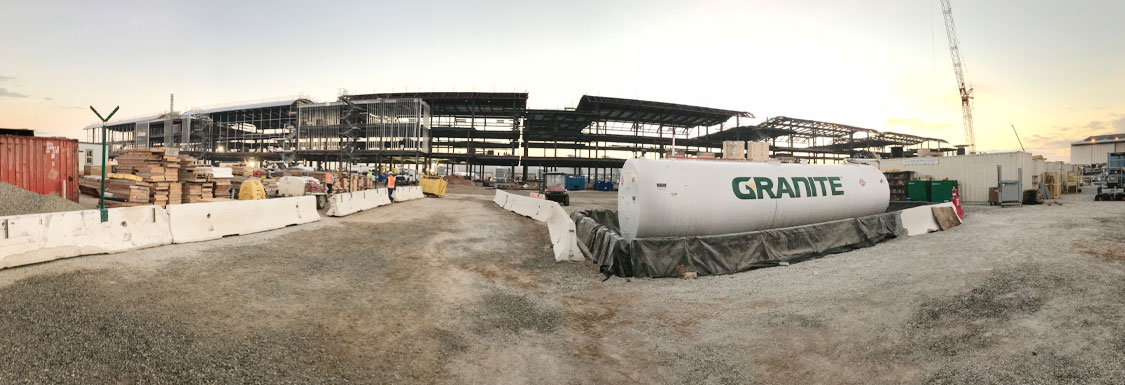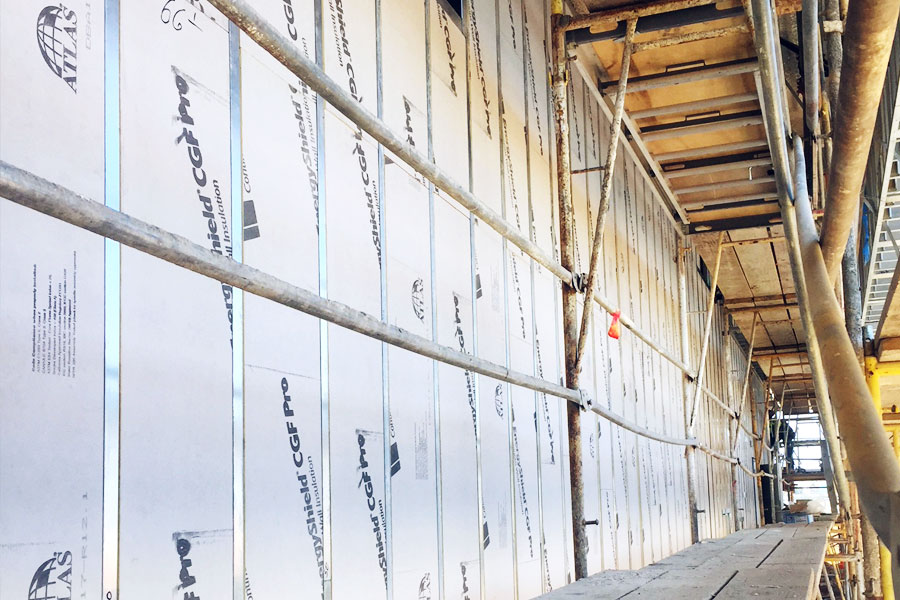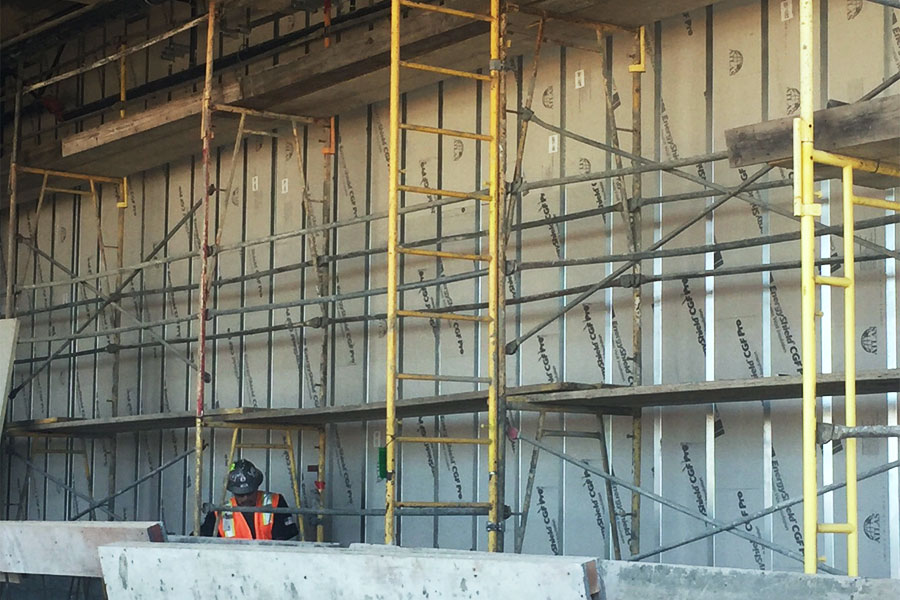Project Challenge
A New State-of-the-Art Concourse

The Los Angeles International Airport (LAX), known as the nation’s third busiest airport, has been undergoing a major overhaul that requires adherence to strict city building codes. With the addition of the Tom Bradley International Terminal (TBIT) in 2013, came a list of projects to be piloted throughout the airport. One of the major projects on that list is the new Midfield Satellite Concourse (MSC) North, a five-level, 750,000 square-foot expansion that will be accessible via a spacious 1,200 ft. long tunnel corridor with moving walkways from the Tom Bradley terminal. With 12 new gates, aircraft parking aprons and taxiways, the new concourse addition will improve operations, enable faster connections, and ease passenger access, all while providing state-of-the-art facilities. Corgan is the lead architecture firm, in association with Gensler and gkkworks (now CannonDesign), on the design build project for the Midfield Satellite Concourse. Turner Construction Company and PCL Construction Services, Inc. are managing the project. Construction, which is a part of a 1.2-billion-dollar initiative, started in February of 2017 and is expected to wrap up in early 2020.
Stringent Code Requirements
With the onset of design, the architects were aware the project had to meet the California Green Building Standards Code (CALGreen) Mandatory and Tier 1 requirements. CALGreen is a state code with mandatory sustainability related requirements, while Tier 1 is a set of voluntary sustainability measures that each jurisdiction has the option to enforce. With their noteworthy commitment to sustainability, Los Angeles World Airport (LAWA) has chosen to require larger projects earn the Tier 1 certification. Tier 1 triggers a higher level of sustainability strategies, among which is the measurement of Diesel Oxidation Catalyst (DOC) on thermal insulation.
CALGreen is the first-in-the-nation mandatory green building standards code. Developed in 2007, it targets the reduction of Greenhouse Gas (GHG) from buildings, while promoting environmentally responsible, cost-effective, healthier places to live and work. The building code also seeks to reduce water consumption and responds to the environmental directives of the many development agencies. The formation of the CALGreen Code has been a vital step toward more efficient and responsible building design throughout California.
In order for the new Midfield Satellite Concourse to meet the CALGreen Tier 1 requirement, the thermal insulation used in the project had to meet key requirements that measured volatile organic compounds (VOC) emissions. The architects needed a thermal building insulation solution that would meet these strict requirements while offering superior performance and fitting within the build budget.
A Wave of Design Needs
Because the new concourse is designed to complement the ocean wave theme of the airport, the architects envisaged a stunning curvilinear roof. This unique design element additionally demanded specific roof and wall configuration requirements. To bring the vision into reality, the team needed insulation materials that could be custom fit to meet their curvature and design needs.
Approach
The design and construction team began searching for an insulation solution that would meet or exceed all code and environmental requirements. Atlas EnergyShield and ACFoam products were continually recommended by industry experts due to their low VOC emissions and optimal performance. To ensure the Atlas products would meet the CALGreen Tier 1 requirement, both the wall and roof insulation solutions went through extensive GREENGUARD Gold testing: Atlas ACFoam®-II for roof insulation and EnergyShield® CGF Pro for wall insulation. Atlas polyiso insulation creates a versatile, effective barrier for thermal, air, moisture and vapor control, which were critical in this application and highly important features to the MSC build and design teams.
GREENGUARD Gold testing requires that products meet some of the world’s most rigorous standards for low emissions of VOCs into indoor environments. This certification provides designers, architects and contractors an easy way to identify premium products that aid in the creation of healthier indoor environments and release fewer pollutants that can contribute to health issues, including asthma and other respiratory issues. These standards are preserved by UL Environment and incorporate health-based emissions criteria established by the U.S. Environmental Protection Agency, State of California and other reputable public health agencies.
“The City of Los Angeles, unlike any other jurisdiction that I have worked with, has a very aggressive approach to sustainability,” said Jennifer Wehling, Sustainability Specialist at Corgan. “When it became clear the Tier 1 thermal insulation prerequisite was seemingly unattainable, the project team worked with the City of LA, the Building Standards Committee, as well as a number of industry experts in the matter to find a solution. We were highly selective in the products we chose to bring this project to life. Having successfully worked with Atlas in the past, we were thankful for their willingness to go through the GREENGUARD Gold testing process.”
After eight weeks of testing, both the Atlas ACFoam-II and EnergyShield CGF Pro products passed the vigorous requirements for GREENGUARD Gold certification. The size and scale of the project was significant. More than 5,000 squares of ACFoam are required on the roof, which represents 500,000 square feet. ACFoam is among the most sustainable and widely used roofing material, and it can be found on high-profile buildings throughout the country. The standard size of an ACFoam panel is 4’x4’ or 4’x8’, but due to the curvature of the roof, Atlas needed to custom make 2’x8’ panels of ACFoam in order to meet the architect’s design needs.
More than 215,000 square feet of Atlas EnergyShield CGF Pro wall insulation will provide the highest
R-value, durability and water resistive barrier attributes to ensure the best building performance. The wall insulation is vapor permeable and composed of a Class A fire-rated (NFPA 285 compliant), closed cell polyiso rigid foam core faced with a high performance coated glass facer on the front and back, which meets all project and code requirements and ensures a continuous insulation solution.
To complete this project, the design build team will utilize a combination of 715,000 square feet of Atlas building products, including Atlas ACFoam roofing insulation and EnergyShield wall insulation.
Impact
In addition to attaining the CALGreen Tier 1 requirement, the build and design teams are aiming for the concourse to be LEED (Leadership in Energy and Environmental Design) Silver certified. LEED is the most widely used green building rating system in the world. It also provides a framework that project teams can apply to create healthy, highly efficient and cost-saving green buildings. With both Atlas ACFoam and EnergyShield CGF Pro being GREENGUARD Gold certified, it will help the project to gain the prestigious LEED Silver certification.
The state of California has taken steps to lower the VOC emissions inside buildings, and by utilizing the Atlas polyiso roof and wall insulation solutions, a healthier indoor environment can be enjoyed by everyone visiting the new Midfield Satellite Concourse at the LAX airport. The new concourse will see major efficiencies, including significant environmental improvements and better thermal insulation management. Atlas products continue to be sought out in high-profile commercial and residential environments due to low VOC emissions and providing an effective yet versatile thermal barrier for air, moisture, and vapor control. All teams involved worked together to make sure products and testing satisfied stringent code requirements. For this project, Atlas was the only manufacturer willing to commit to the GREENGUARD Gold testing standard, obtaining certifications for insulation requirements that will not only help projects earn the stringent CALGreen Tier 1 certification, but also provide new options for projects seeking LEED v4 certification, setting a new standard for what architects and builders can achieve in future projects.





